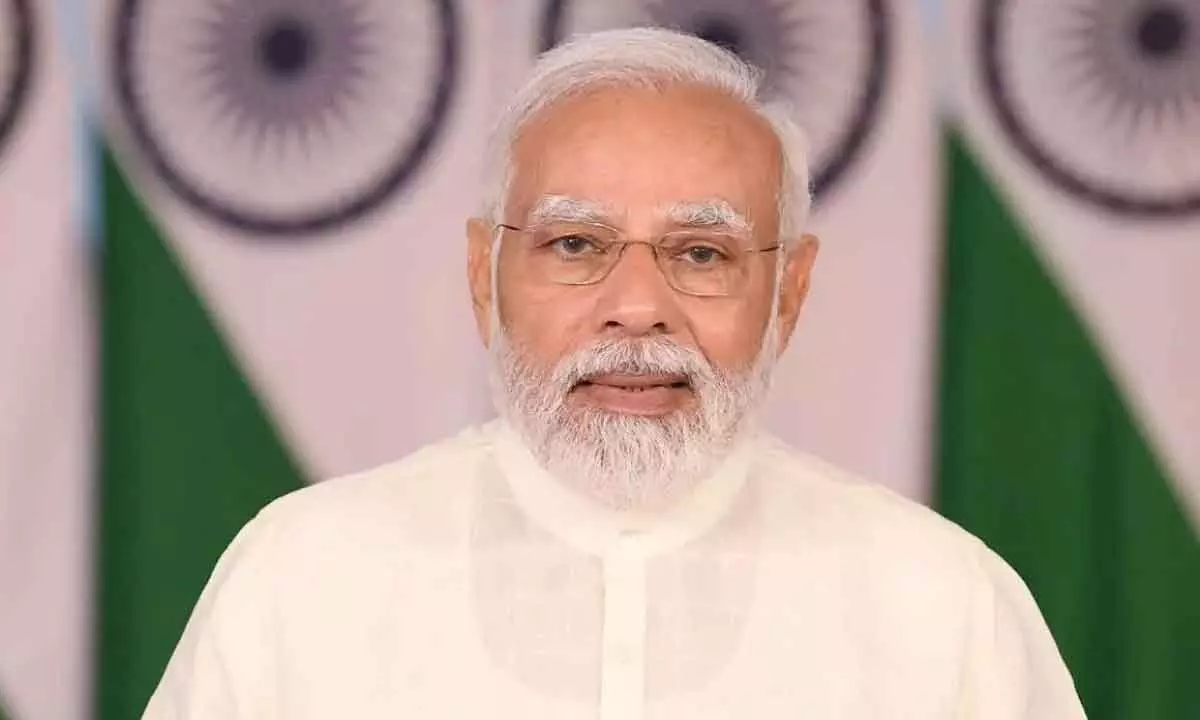Live
- Over 7,600 Syrians return from Turkiye in five days after Assad's downfall: minister
- Delhi BJP leaders stay overnight in 1,194 slum clusters
- Keerthy Suresh and Anthony Thattil Tie the Knot in a Christian Ceremony
- AAP, BJP making false promises to slum dwellers for votes: Delhi Congress
- 'Vere Level Office' Review: A Refreshing Take on Corporate Life with Humor and Heart
- Libya's oil company declares force majeure at key refinery following clashes
- Illegal Rohingyas: BJP seeks Assembly session to implement NRC in Delhi
- Philippines orders full evacuation amid possible volcanic re-eruption
- Government Prioritizes Welfare of the Poor, says Dola Sri Bala Veeranjaneyaswamy
- Two Russian oil tankers with 29 on board damaged due to bad weather
Just In
Instead of flaying PM, see the big picture


Prime Minister Narendra Modi
In yet another step to boost fertiliser production in the country, Prime Minister Narendra Modi will inaugurate a fertiliser plant at Ramagundam in Telangana on November 12.
In yet another step to boost fertiliser production in the country, Prime Minister Narendra Modi will inaugurate a fertiliser plant at Ramagundam in Telangana on November 12. It is the same plant for which he laid the foundation on August 7, 2016. There is a huge controversy over the same now in Telangana. The ruling Telangana Rashtra Samithi (TRS), which is not a friend of the BJP and which has mounted a fresh attack on Narendra Modi in the recent times, accuses him of inaugurating a plant that has gone into production already.
The issue is not whether the Prime Minister should be inaugurating it now. It is more about the plant becoming operational (as it has become since some time). The larger picture of 'Atmanirbhar Bharat' must not be forgotten. Ever since he has come to power, Narendra Modi has made special efforts for the revival of fertiliser plants lying closed for many years. The driving force behind the revival of the fertiliser plants across the country is the vision of the Prime Minister to achieve self-sufficiency in production of urea. There cannot be any dispute over the same.
Modi has always put special focus on increasing indigenous fertiliser production and timely supply of fertiliser to farmers. The government notified the New Urea Policy 2015 for existing 25 gas-based urea units with the objective of maximising indigenous urea production; promoting energy efficiency in urea production; and rationalising subsidy burden on the government. In December 2021, Prime Minister dedicated to the nation the Gorakhpur Fertiliser Plant, whose foundation stone was also laid by him on July 22, 2016. This plant had been lying shut for more than 30 years; it was revived and built at a cost of around Rs. 8,600 crore.
Last month in October, Barauni Plant of Hindustan Urvarak and Rasayan Limited (HURL) also commenced urea production. Government had mandated HURL to revive the Barauni plant with an estimated investment of more than Rs 8,300 crore with urea production capacity of 12.7 LMTPA (lakh metric tonne per annum). The Sindri unit of the Hindustan Urvarak and Rasayan Limited (HURL) two days earlier commenced commercial production of urea. PM Modi had laid the foundation stone for the revival of the Sindri Fertiliser project of HURL on 25 May 2018. Similarly, he had also laid the foundation stone for revival of Talcher fertiliser project on 22 September 2018. This plant is based on coal gasification technology and is expected to be commissioned in 2024.
After operationalisation of all these urea plants at Ramagundam, Gorakhpur, Sindri, Barauni and Talcher, they will add to 63.5 LMT per annum of urea leading to reduction in the import of urea. They will help significantly in moving closer to the goal of achieving Aatmanirbharta in Urea production. The implementation of the New Urea Policy-2015 has led to additional production from the existing gas based urea units due to which the actual production of urea has increased significantly.
India now imports urea from a number of countries, including Oman, Qatar, Saudi Arabia and United Arab Emirates. Due to higher global prices India's fertiliser subsidy bill for the fiscal year to March 31, 2023, would rise to a record Rs 2.25 lakh crore ($27.21 billion) from previous year's about Rs 1.5 lakh crore according to the Centre. Urea accounts for about 70 per cent of the fertiliser subsidy. For someone aspiring to be a national party, some national outlook will do good.

© 2024 Hyderabad Media House Limited/The Hans India. All rights reserved. Powered by hocalwire.com






